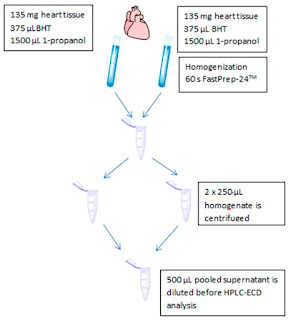Determination of Reduced and Oxidized Coenzyme Q10 in Canine Plasma and Heart Tissue by HPLC-ECD: Comparison with LC-MS/MS Quantification.
Coenzyme Q10 (Q10) plays an important role in mammals for energy production in the mitochondria, and as a powerful antioxidant. Oxidation Ratio (% oxidized in relation to the amount of Q10) has been proposed as an important biomarker.
An HPLC-ECD method is sensitive and Equine Serum Albumin reproducible developed for the determination of reduced and oxidized Q10 in dog plasma and heart tissue. chromatographic separation is achieved within 10 minutes by using the column Waters Nova-pak C18 and the mobile phase with lithium perchlorate in ethanol / methanol / 2-propanol. validation show satisfactory results. a very good linear correlation was found (r 2> 0.9997), intra- and inter-day precision were below 6.5% (n = 5) and the recovery is between 89 and 109% (n = 5).
The sensitivity is expressed as the Lower Limit Quantification (LLOQ) was 10 nM. acceptable stability of both samples extracted and un-extracted observed. Total plasma concentration range Q10 is found between 0.64 and 1.24 ug / mL. Comparison with the method of LC-MS / MS forward showing a correlation of r = 0.85 to reduce Q10 and r = 0.60 for the oxidized Q10 (N = 17). However, the average yield is about 30% lower for ubiquinol using LC-MS / MS compared with HPLC-ECD analysis. Two methods are therefore not considered to be interchangeable
coagulation factor activity in units nonleukoreduced dog leukoreduced and fresh-frozen plasma.
To evaluate the coagulation factors in units leukoreduced (LR) and nonleukoreduced (non-LR) dog fresh-frozen plasma (cFFP) 0.8 sound research dogs.In crossover study, dogs were randomly assigned to 1 of 2 groups of which the blood was collected and whether or not to undergo leukoreduction. After a recovery period ≥ 28 days, dogs were switching between protocols.
After each collection, blood samples were centrifuged, and cFFP was stored frozen for later analysis comparative coagulation factors, antithrombin and protein C activity (reported as a percentage of the appropriate ratio of activities specified in the standard dog plasma collected); prothrombin and activated partial thromboplastin time; and fibrinogen concentration.
There no significant difference was detected Feline Plasma between the results for LR cFFP, compared with those for non-LR cFFP.Although there are variations between the residual activity of coagulation factors in the LR and non-LR cFFP, variations and differences are considered unlikely impact properties cFFP LR transfused to coagulation factor replacement in dogs.
However, because of the small sample size and high variability results in this study, additional studies with sample sizes are needed for definitive conclusions about the effects of leukoreduction on coagulation factors in cFFP and to develop treatment guidelines for use LR cFFP in dogs with congenital and acquired coagulopathies.

Comments
Post a Comment